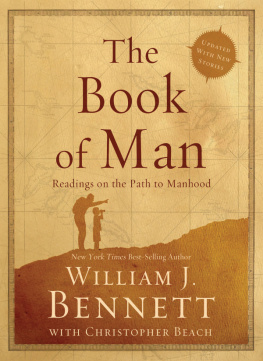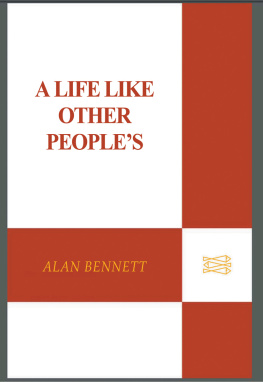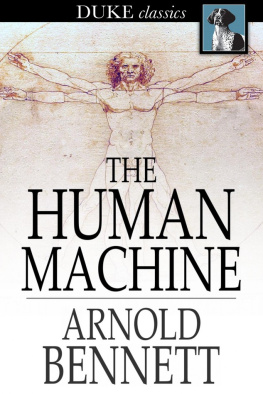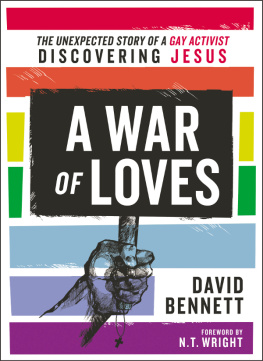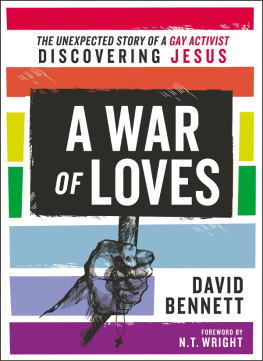
2016 William J. Bennett
All rights reserved. No portion of this book may be reproduced, stored in a retrieval system, or transmitted in any form or by any meanselectronic, mechanical, photocopy, recording, scanning, or otherexcept for brief quotations in critical reviews or articles, without the prior written permission of the publisher.
Published in Nashville, Tennessee, by Nelson Books, an imprint of Thomas Nelson. Nelson Books and Thomas Nelson are registered trademarks of HarperCollins Christian Publishing, Inc.
Thomas Nelson titles may be purchased in bulk for educational, business, fund-raising, or sales promotional use. For information, please e-mail SpecialMarkets@ThomasNelson.com.
Unless otherwise noted, Scripture quotations are taken from the Holy Bible, New International Version, NIV. Copyright 1973, 1978, 1984, 2011 by Biblica, Inc. Used by permission of Zondervan. All rights reserved worldwide. www.zondervan.com. The NIV and New International Version are trademarks registered in the United States Patent and Trademark Office by Biblica, Inc.
Scripture quotations marked DRB are from the Douay-Rheims Bible (public domain).
Scripture quotations marked ESV are from the ESV Bible (The Holy Bible, English Standard Version). Copyright 2001 by Crossway, a publishing ministry of Good News Publishers. Used by permission. All rights reserved.
Scripture quotations marked NASB are from New American Standard Bible. Copyright 1960, 1962, 1963, 1968, 1971, 1972, 1973, 1975, 1977, 1995 by The Lockman Foundation. Used by permission. (www.Lockman.org)
Any Internet addresses, phone numbers, or company or product information printed in this book are offered as a resource and are not intended in any way to be or to imply an endorsement by Thomas Nelson, nor does Thomas Nelson vouch for the existence, content, or services of these sites, phone numbers, companies, or products beyond the life of this book.
ISBN 978-0-7180-1871-9 (eBook)
Library of Congress Cataloging-in-Publication Data
Bennett, William J. (William John), 1943
Tried by fire : the story of Christianity's first thousand years / William J. Bennett.
pages cm
Includes bibliographical references and index.
ISBN 978-0-7180-1870-2
1. Church history--Primitive and early church, ca. 30-600. 2. Church history--Middle Ages, 600-1500. I. Title.
BR162.3.B465 2016
270--dc23
2015033527
16 17 18 19 20 RRD 10 9 8 7 6 5 4 3 2 1
To those Christians around the world who are still tried by fire and who have given everything for their faith.
CONTENTS
C hristians in North America and Europe have always looked forward to celebrating Christmas. The sense of anticipation surrounding the holiday is an indication of what it offers: rejoicing in the Saviors birth, chances to celebrate traditions with family, the exchange of gifts, time off work, and so much more. But Christians around the world dont always have that same sense of anticipation. For some, the approach of the day can be clouded with dread. Lets examine some events of the season that took place around the globe to see why:
In Somalia, fourteen peacekeepers were killed by Islamist militants as they celebrated Christmas.
In Iran, seven Christians were hung at dawn on Christmas Day.
In Kenya, thirty-six Christians in a work camp near the Somali border were either shot or beheaded by Islamist gunmen.
In Pakistan, a twenty-eight-year-old woman, already the mother of four children and pregnant with another, was forced to walk naked through town and beaten with pipes by her employers. She miscarried. The charge against her? Being a Christian.
And the story of persecution and martyrdom continues; there is more Christian persecution now around the world than at any time in history. Pope Francis made headlines when he suggested as much in 2014.
The persecution of Christians is a dismal reality. And yet to Christians it is nothing new. The reignition of persecution of Christians around the worldin Iraq and Syria, Nigeria and Somalia, Pakistan and Indiarecalls the first few centuries after Christ, when devastation of the church was normal in places that are relatively tolerant today, like Italy, France, and Spain.
This book is the story of that early church, and predominantly its endurance through persecution. The burnings, beheadings, and other tortures of the first few centuries AD did not quash the ability of Christians everywhere to persist in belief. On the contrary, it is clear from the sources from the era that the ravages visited upon the church actually strengthened it. As the third-century writer Tertullian declared, The blood of the martyrs is the seed of the church. Such a phenomenon is so counterintuitive and so supernatural that it deserves new attention here. Most aspects of the growth and theology of the early Christian church are explored here, but special focus is given to how it endured centuries as a target of violence. Stories of Maximus the Confessor, whose tongue was cut out, or Perpetua, who was gored by a bull before being stabbed to death, still cry out to us and remind us of our spiritual roots.
Biography is one of the most excellent ways of teaching history. Consequently, Tried by Fire also has a heavily biographical focus. Great weight is given to the accomplishments, inner conflicts, and vital details of scholars (Augustine, Jerome), preachers (John Chrysostom, Gregory Nazianzus), missionaries (Pope Gregory, Saint Boniface), kings (Constantine, Justinian), and eccentrics (Simeon the Stylite, who lived atop a pillar in the desert; and Origen, who castrated himself). Their stories help illustrate the remarkable nature of their lives and times, and show how the extraordinary depth of their convictions shaped the world. Many of them are very graphic, and I warn the reader ahead of time of some disturbing material.
One of the difficulties in writing a book on the church is that there are so many definitions of what a Christian is. In the centuries since Christ founded his church, divisions over matters great and small have split the church into different sects, with the main divisions being Catholic, Protestant, and Orthodox. The theological framework I employ in this book tries to encompass the most basic points of belief shared among all three. I acknowledge that each group will have, according to its own theological rubric, very different interpretations of the same historical events. The intent of Tried by Fire is not so much to declare what turns of history were right or wrong (except in the most obvious cases, such as the Arian denial of the divinity of Christ or the perversions of the tenth-century papacy), but to describe the causes and effects of various events in the first thousand years of the church.
There are already many excellent books on the Christian church. Men have, in fact, been writing histories of the church since the book of Acts. In recent decades, books like Robert Wilkens The First Thousand Years and Justo Gonzlezs The Story of Christianity have told the story more than adequately. For clarification, you will notice many factual claims common to church historians that are not accompanied by footnotes. This decision not to cite every fact was made purely out of a consideration of added time to completion of the book and the length of the manuscript, and not a desire to obfuscate my sources. I am indebted to those books and others for much of the research for this book, but it is time to tell more fully this bloody part of the churchs story.
In the mid-first century, the apostle Peter wrote to a church suffering persecution. He wanted them to understand that it was not for nothing. He urged that the trial of your faith (much more precious than gold which is tried by the fire) may be found unto praise and glory and honour at the appearing of Jesus Christ (1 Peter 1:7 DRB). I hope that your faith will be strengthened by reading the accounts of those who have come, thought, written, and suffered before us.
Next page

